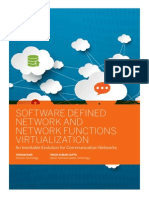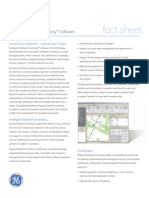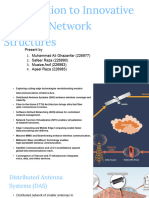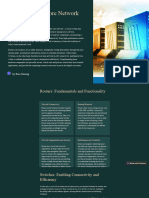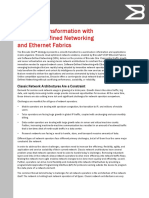0 ratings0% found this document useful (0 votes)
128 viewsSpatialnet: End-To-End Physical Network Inventory Management
Spatialnet: End-To-End Physical Network Inventory Management
Uploaded by
talhaspatialnet info
Copyright:
© All Rights Reserved
Available Formats
Download as PDF, TXT or read online from Scribd
Spatialnet: End-To-End Physical Network Inventory Management
Spatialnet: End-To-End Physical Network Inventory Management
Uploaded by
talha0 ratings0% found this document useful (0 votes)
128 views3 pagesspatialnet info
Original Title
Spatial Net
Copyright
© © All Rights Reserved
Available Formats
PDF, TXT or read online from Scribd
Share this document
Did you find this document useful?
Is this content inappropriate?
spatialnet info
Copyright:
© All Rights Reserved
Available Formats
Download as PDF, TXT or read online from Scribd
Download as pdf or txt
0 ratings0% found this document useful (0 votes)
128 views3 pagesSpatialnet: End-To-End Physical Network Inventory Management
Spatialnet: End-To-End Physical Network Inventory Management
Uploaded by
talhaspatialnet info
Copyright:
© All Rights Reserved
Available Formats
Download as PDF, TXT or read online from Scribd
Download as pdf or txt
You are on page 1of 3
spatialNET
END-TO-END PHYSICAL NETWORK INVENTORY MANAGEMENT
A current and accurate physical network inventory is a critical aspect when
managing a successful communications network. However, many
communications service providers are faced with the challenge of Key Benefits
maintaining constantly evolving network data. New build-out, network Increased efficiency in
configuration changes, repairs, and the migration to new network drafting and design
technologies all contribute to making asset management a formidable task. shortens the time from
To remain competitive, organizations need an agile network management build-out to activation
solution that can be integrated throughout the enterprise. and increases revenue
opportunities
The core component of the spatialSUITE portfolio, spatialNET enables
service providers of any size and network architecture to efficiently manage Equipment dictionaries
physical network data. Planners, designers, and engineers utilize and design profiles
spatialNET’s sophisticated design and engineering tools to create and enforce standards to
manage accurate network asset data, while asset managers and system ensure networks are built
integrators leverage its scalable information model to deliver data in as designed, reducing
real-time to users and systems across the organization, including construction, as-built, and
provisioning, billing, assurance, and other critical OSS/BSS functions. maintenance costs
Detailed documentation
DESIGN AND MANAGE THE ENTIRE NETWORK of network assets allows
for optimal provisioning
Utilizing a familiar CAD-based UI for designing fiber, RF, HFC, and of equipment
twisted-pair communications networks, spatialNET provides engineers with
a fully configurable, spatially-enabled information model. With the use of Up-to-date reporting of
configurable tools, users are able to design networks and manage asset data network assets reduces
efficiently in an intelligent design interface that renders network component the need for field audits
details in a real-world, visual environment. Users can model the full and lowers mean-time-to
end-to-end physical network through all cables, buildings, structures, and -repair, reducing the need
equipment. Additional design capabilities include: for costly truck rolls
Dynamic connection to network assets through intelligent equipment End-to-end network
association, allowing automatic recalculation of strand and cable lengths connectivity enables fast
as the network evolves location of faults, losses,
and outages, providing
Accurate bill of materials (BOM) reports generated from details designs efficient resolution of
to facilitate planning and inventory management network issues
Unique asset identifier tracking, including serial numbers, bar codes, RFID
tags, and CLLI codes
Extensive tracing capabilities across all network architectures to analyze
connectivity and service availability
Browse, search, and edit tools allow the largest network inventories to be
managed with a higher degree of efficiency and currency
©Synchronoss, Inc. All Rights Reserved. 2016 1
FIBER NETWORK DESIGN AND MANAGEMENT
spatialNET includes a rich fiber network model that supports a variety of active (Active Ethernet) and passive (PON,
GPON) fiber-to-the-home network deployment architectures as well as fiber backhaul networks. spatialNET also
supports fiber microduct network architectures, allowing for them to be efficiently designed in spatialNET, with a
completely connected model of ducts that can be managed to document capacity as ducts are filled at each phase of
project roll-out. Additional design and management features built into spatialNET for fiber networks include:
Detailed modeling for fibers, buffer tubes, blown Complete length management for aerial and
fiber, ducts, microducts, trays, and ribbon cables underground cables, loops, and risers
Complete modeling for inside plant with Inside Data Tracking of usage, ownership, and priority of fiber
Management (IDM) network assets
Channel multiplexing on individual fibers for CWDM Advanced network topology for managing
and DWDM splicing details
Advanced capacity management, planning, and Reporting and integration capabilities for network-
ring-modeling for identifying diverse network paths to-address and network-to-device functionality
Fiber location capabilities with available physical “Master circuit” configurability for network
capacity (dark fiber) and logical capacity (unused elements, enabling physical bearer support for
wavelengths or channels) logical inventory systems
RF NETWORK DESIGN AND MANAGEMENT
With advanced route design, splicing, cable, and associated equipment management capabilities, spatialNET can
model HFC networks and RF signals, amplifiers, and power from the central office or head end, through the field, and
all the way to the customer premises. spatialNET’s integrated design allows designers to build networks that meet
ever-increasing customer demands for high-bandwidth data, telephone, internet, video-on-demand, and HD television
services. By utilizing spatialNET to design and manage their network, communications service providers are able to
meet these needs effectively and efficiently. spatialNET’s design capabilities for HFC networks also include:
Automatic signal-leveling to correctly calculate and Tracking of individual fiber-to-buss port
propagate signal levels across the network assignments at the node
Color-coded visual warnings for tracking selected Automatic configuration and placement of taps and
signal-level tolerances on all equipment and cables passive devices, with configurable warnings when
return signals are out of design specifications
Centralized and distributed power support and
forward- and return-path management for all Customizable options for modeling RF tap power
HFC architecture calculations as a linear or polynominal shape
COPPER DESIGN AND MANAGEMENT
In addition to supporting fiber and RF networks, spatialNET also manages copper loop networks, enabling operators
transitioning from copper to a fiber network to leverage their network asset data in a spatially-enabled repository.
Service providers operating a multi-technology network such as fiber-to-the-curb (FTTC) with VDSL runs to the
home, are also able to access network data through a single enterprise network asset management platform.
spatialNET support for copper networks includes:
Inline equipment location (load coils, bridges, taps, Complete tracking and management of ducts,
and others) supports next-generation services such conduits, and manholes, along with associated lease
as ADSL and IPN agreements and Continuing Property Records (CPR)
Detailed reporting on loop composition and DSL End-to-end connectivity for tracking
service qualifications, with upstream and physical-bearer and special-usage information,
downstream tracing at the sheath or circuit level providing the full physical path for integration with
logical inventory systems
Definitions for special usages (T1, DSL) or copper
pairs to keep physical records current and accurate
©Synchronoss, Inc. All Rights Reserved. 2016 2
INSIDE DATA MANAGEMENT
spatialNET’s Inside Data Management (IDM) tools enable users to seamlessly model end-to-end network
connectivity from inside plant to outside plant, with full tracing capabilities through all assets, including head-ends,
hubs, central offices, commercial complexes, and any building site type. Key features of IDM include:
Ability to model risers from floor to floor Operate over LAN and WAN network environments.
All functions, rules, and graphical symbology are
Support for multi-floor facilities
configurable to comply with any system’s standards
Ability to model floors, rooms, aisles, closets, and
Configurable Port Groups
addresses
Sub-equipment port mapping
Improved space management, including IDM Location
Finder and sub-slots Schematic views showing port-to-port connectivity
between devices
Automated generation of rack elevation and network
ortho-schematic views directly from the database Full integration with CAD for precise data entry and
high quality visual output
QA checks and automation functions to ensure valid
and consistent network documentation
JOB MANAGEMENT SYSTEM
spatialNET leverages a sophisticated job management system (JMS) that allows multiple users to work in the same
area simultaneously for long periods of time. JMS control ensures database integrity by providing a consistent set of
data during a design job, and keeps work-in-progress separate from the as-built data. spatialNET also tracks the
detailed status of every asset in a job using a configurable state model, providing a real time view of the operational
status of the network. Using the JMS framework, large projects containing multiple designs can be managed
effectively to provide better visibility on completion status and the future network. To help model the design
workflow as it occurs in the real work, JMS also supports:
Creation and management of job scenarios to test A partial posting solution for the subset of a design
design alternatives job that has actually been built
The creation of dependencies between jobs to Conflict detection between different job scenarios
enforce the order of posting
spatialNET is part of the spatialSUITE portfolio of network asset management products available from Synchronoss.
For more information on spatialNET and the other broadband solutions available from Synchronoss, please visit our
website at http://www.synchronoss.com.
©Synchronoss, Inc. All Rights Reserved. 2016 3
You might also like
- Mobile Computing Deployment and Management: Real World Skills for CompTIA Mobility+ Certification and BeyondFrom EverandMobile Computing Deployment and Management: Real World Skills for CompTIA Mobility+ Certification and BeyondNo ratings yet
- IT Operations Management Team A Complete Guide - 2021 EditionFrom EverandIT Operations Management Team A Complete Guide - 2021 EditionNo ratings yet
- Network Management System A Complete Guide - 2020 EditionFrom EverandNetwork Management System A Complete Guide - 2020 EditionRating: 5 out of 5 stars5/5 (1)
- Network Segmentation Strategy A Complete Guide - 2021 EditionFrom EverandNetwork Segmentation Strategy A Complete Guide - 2021 EditionNo ratings yet
- Understanding UMTS Radio Network Modelling, Planning and Automated Optimisation: Theory and PracticeFrom EverandUnderstanding UMTS Radio Network Modelling, Planning and Automated Optimisation: Theory and PracticeMaciej NawrockiNo ratings yet
- Triple Play: Building the converged network for IP, VoIP and IPTVFrom EverandTriple Play: Building the converged network for IP, VoIP and IPTVNo ratings yet
- Ethernet Networks: Design, Implementation, Operation, ManagementFrom EverandEthernet Networks: Design, Implementation, Operation, ManagementRating: 4 out of 5 stars4/5 (1)
- VoIP and Unified Communications: Internet Telephony and the Future Voice NetworkFrom EverandVoIP and Unified Communications: Internet Telephony and the Future Voice NetworkNo ratings yet
- Radio Spectrum Management: Policies, Regulations and TechniquesFrom EverandRadio Spectrum Management: Policies, Regulations and TechniquesNo ratings yet
- LTE Self-Organising Networks (SON): Network Management Automation for Operational EfficiencyFrom EverandLTE Self-Organising Networks (SON): Network Management Automation for Operational EfficiencySeppo HämäläinenNo ratings yet
- The Telecommunications Handbook: Engineering Guidelines for Fixed, Mobile and Satellite SystemsFrom EverandThe Telecommunications Handbook: Engineering Guidelines for Fixed, Mobile and Satellite SystemsNo ratings yet
- Fundamentals of Cellular Network Planning and Optimisation: 2G/2.5G/3G... Evolution to 4GFrom EverandFundamentals of Cellular Network Planning and Optimisation: 2G/2.5G/3G... Evolution to 4GNo ratings yet
- The 5G Revolution: How the Next Generation of Wireless Will Change EverythingFrom EverandThe 5G Revolution: How the Next Generation of Wireless Will Change EverythingNo ratings yet
- Telecommunications: Glossary of Telecommunications TermsFrom EverandTelecommunications: Glossary of Telecommunications TermsNo ratings yet
- Emerging Technologies in Information and Communications TechnologyFrom EverandEmerging Technologies in Information and Communications TechnologyNo ratings yet
- Spatialnet: End-To-End Physical Network Inventory ManagementDocument3 pagesSpatialnet: End-To-End Physical Network Inventory ManagementDoraoraNo ratings yet
- Spatial Net IntroductionDocument4 pagesSpatial Net Introductionsyed100% (1)
- Network TechnologyDocument13 pagesNetwork Technologyjerickculaniban.coscaNo ratings yet
- Vnit-V LSI Architecture For Multitier Wireless System PDFDocument4 pagesVnit-V LSI Architecture For Multitier Wireless System PDFStranger TuckerNo ratings yet
- EnRoute500 Mesh Sample Design ReportDocument60 pagesEnRoute500 Mesh Sample Design ReportnggianglxNo ratings yet
- Mentum Ellipse Brochure PDFDocument8 pagesMentum Ellipse Brochure PDFd-fbuser-68257520No ratings yet
- Aruba CX 10000 Series DatasheetDocument14 pagesAruba CX 10000 Series Datasheet阿奇阿奇No ratings yet
- Seroj HacobianDocument4 pagesSeroj Hacobianmamta kumariNo ratings yet
- Software Defined Network and Network Functions VirtualizationDocument16 pagesSoftware Defined Network and Network Functions VirtualizationSaksbjørn Ihle100% (1)
- Fibcom 6300NMS PDFDocument2 pagesFibcom 6300NMS PDFRaja SolaimalaiNo ratings yet
- Deploying Pragmatic Techniques For Campus Network Design: Aditya Ahuja, Nikita Gupta, Kamal Dewan, Meenakshi SoodDocument6 pagesDeploying Pragmatic Techniques For Campus Network Design: Aditya Ahuja, Nikita Gupta, Kamal Dewan, Meenakshi SoodBaktiar HossainNo ratings yet
- Cisco Controller Based WLANDocument4 pagesCisco Controller Based WLANjumyarif2905No ratings yet
- Case Study Cargo Tunnel Refurbishment v0Document2 pagesCase Study Cargo Tunnel Refurbishment v0Rashid HassanNo ratings yet
- 6500 Packet Optical Platform PBDocument9 pages6500 Packet Optical Platform PBIan Chris ValencerinaNo ratings yet
- EnRoute500 Mesh Sample Design ReportDocument60 pagesEnRoute500 Mesh Sample Design ReporttogarsNo ratings yet
- Tactical Area Communications SystemDocument10 pagesTactical Area Communications SystemYasir ShigileeniNo ratings yet
- Pni Fact SheetDocument2 pagesPni Fact SheetDe Firsta EpynoyaNo ratings yet
- MX Series 3D Universal Edge Routers: Product OverviewDocument8 pagesMX Series 3D Universal Edge Routers: Product OverviewAtif NoorNo ratings yet
- Introduction To Innovative Telecom Network StructuresDocument11 pagesIntroduction To Innovative Telecom Network Structuresm.zeeshanpc1No ratings yet
- Introduction To Core Network ComponentsDocument10 pagesIntroduction To Core Network Componentskad feroNo ratings yet
- Data Center Best Practices Ebook CH4 CO-110101-EnDocument7 pagesData Center Best Practices Ebook CH4 CO-110101-EnDavid Amado Vaca LanzaNo ratings yet
- Network TransformationDocument6 pagesNetwork TransformationMumtaz AhmadNo ratings yet
- Data-Center-Solution-Guide v2 en LRDocument47 pagesData-Center-Solution-Guide v2 en LRgetthekijijiguyNo ratings yet
- Demystifying NFV in Carrier NetworksDocument8 pagesDemystifying NFV in Carrier NetworksGabriel DarkNo ratings yet
- Echelon Smart Server InfoDocument4 pagesEchelon Smart Server InfoAlexis ZapataNo ratings yet
- HP Data Center Networking Solutions BrochureDocument12 pagesHP Data Center Networking Solutions BrochurebatetyNo ratings yet
- Social Studies Subject For Middle School - 8th Grade - Geography and Colonialism XL by SlidesgoDocument88 pagesSocial Studies Subject For Middle School - 8th Grade - Geography and Colonialism XL by SlidesgoAfonso OliveiraNo ratings yet
- Micro Project Report OnDocument11 pagesMicro Project Report OnMayur NarsaleNo ratings yet
- FY21 QBOA Module 4 Reporting Supplemental GuideDocument69 pagesFY21 QBOA Module 4 Reporting Supplemental Guideva.amazonsellercentralNo ratings yet
- DLMS Blue Book 4Th Edition InternetDocument97 pagesDLMS Blue Book 4Th Edition InternetHung NguyenNo ratings yet
- Anton Burtsev's Homepage - OSDocument7 pagesAnton Burtsev's Homepage - OSnntuonNo ratings yet
- The Ultimate Guide To: Office 365Document24 pagesThe Ultimate Guide To: Office 365SmilyAkankshaNo ratings yet
- Spid ReadmeDocument20 pagesSpid ReadmeanjNo ratings yet
- Explanations of Various Types of Video Editing ToolsDocument5 pagesExplanations of Various Types of Video Editing Toolsnilu royNo ratings yet
- Project Dbms1Document5 pagesProject Dbms1Khandu BeleNo ratings yet
- PCI Express SolutionsDocument8 pagesPCI Express SolutionsAruna KandimallaNo ratings yet
- PDF Computer Science A Structured Programming Approach Using C 3rd Edition Word MD CompressDocument3 pagesPDF Computer Science A Structured Programming Approach Using C 3rd Edition Word MD CompressSwetha D50% (2)
- 38 TerraSyncInstallationDocument2 pages38 TerraSyncInstallationJose YoveraNo ratings yet
- Data Encryption Techniques and StandardsDocument59 pagesData Encryption Techniques and StandardsRajan Jamgekar100% (1)
- Solved QNA 2074 SEDocument8 pagesSolved QNA 2074 SEDeepak OliNo ratings yet
- Presentation (ECE452)Document32 pagesPresentation (ECE452)Hager AhmedNo ratings yet
- Unity University: Submitted To: - Mesfin Abebe (PHD) January 24, 2020Document14 pagesUnity University: Submitted To: - Mesfin Abebe (PHD) January 24, 2020አረጋዊ ሐይለማርያምNo ratings yet
- LTE X2 Handover Call Flow Procedure LTEDocument10 pagesLTE X2 Handover Call Flow Procedure LTEAgus SalimNo ratings yet
- Nexus 9000 Series Update BDM - 041824ADocument25 pagesNexus 9000 Series Update BDM - 041824AtobiharyotoNo ratings yet
- Python Package Management 08Document57 pagesPython Package Management 08Zaki IndraNo ratings yet
- ICM Module 1 MCQDocument29 pagesICM Module 1 MCQayat28aymanNo ratings yet
- MITx SCX KeyConcept SC4x FVDocument66 pagesMITx SCX KeyConcept SC4x FVRamkrishna GhagNo ratings yet
- Specification: Approved by DaxiangDocument17 pagesSpecification: Approved by DaxiangRiatNo ratings yet
- Mobile: +91 - 8012469052: Siemens: PLC: S7-400 H Systems, S7-400, S7Document2 pagesMobile: +91 - 8012469052: Siemens: PLC: S7-400 H Systems, S7-400, S7Spartan KskNo ratings yet
- Quadratic EquationsDocument3 pagesQuadratic EquationsamiteejmNo ratings yet
- Types of SoftwareDocument11 pagesTypes of SoftwareJorinda EvangelistaNo ratings yet
- KpopDocument16 pagesKpopJoana villacerNo ratings yet
- Course 1 Module 02 Lesson 4Document9 pagesCourse 1 Module 02 Lesson 4rastparul1No ratings yet
- DM24Document81 pagesDM24Alfabi Muhlisin SaktiNo ratings yet
- Shimadzu Sonavision Versa I.G.Document67 pagesShimadzu Sonavision Versa I.G.Luis Fernando Garcia SNo ratings yet
- APN SettingsDocument24 pagesAPN Settingssyed nizam syed omarNo ratings yet










































